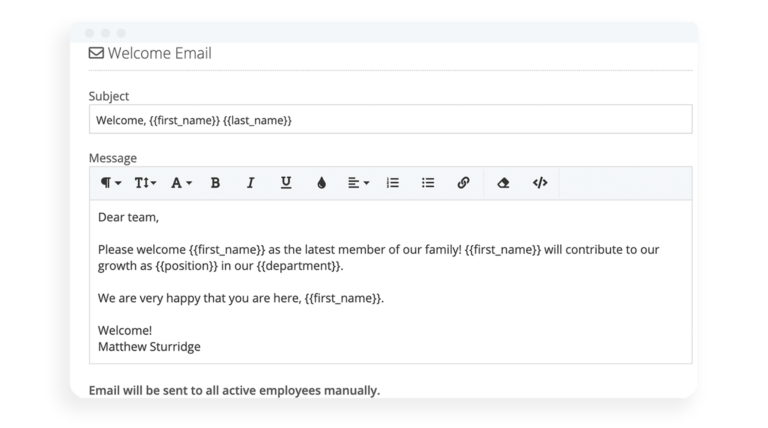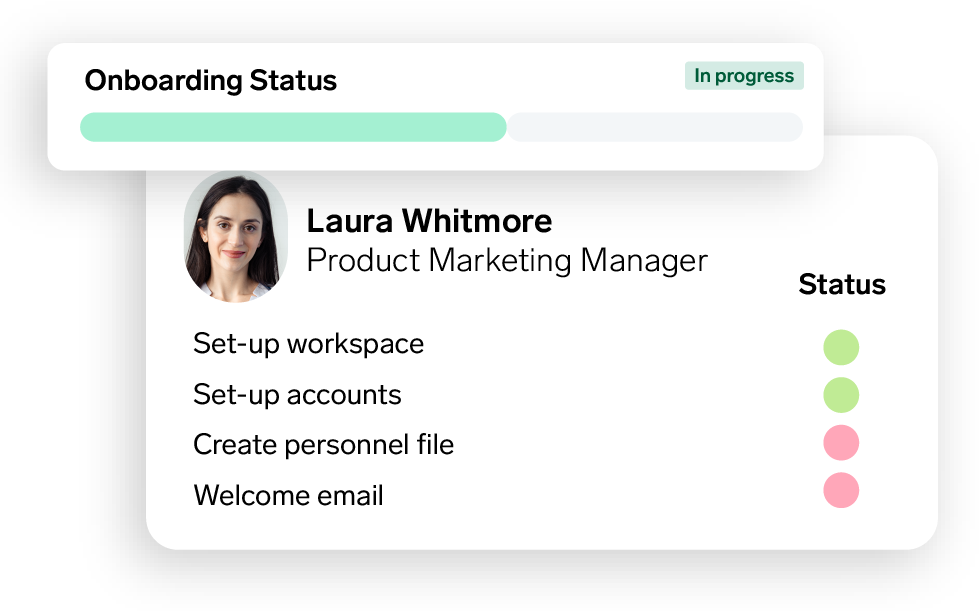
Improve employee onboarding
Discover strategies to enhance your employee onboarding process for a smoother transition.
Read our guideEmployee induction: A comprehensive guide to setting new hires up for success

Need a checklist for induction at work? While some may call it onboarding, others call it an introduction and it basically means to prepare employees to succeed from their very first day of work. This should be phased and you need to have a idea of where your employees should ideally be by their first, third and sixth month at your organisation.
The importance of employee induction
A well-structured induction programme can significantly impact employee retention and engagement. By providing new hires with the necessary information, training, and support, induction helps employees feel welcomed, valued, and informed, leading to increased job satisfaction and a sense of belonging.
But what does that entail? In this article, we offer a helpful employee induction checklist that, when paired with an automated onboarding process, can ensure employees are off to a flying start.
Assign onboarding templates within Personio's HR software. Find out how here.
Contents
- 1What is employee induction?
- 2Benefits of a c
- 3The critical elements of an effective induction program
- 4How to build an induction checklist that works
- 5Avoiding common pitfalls in employee induction
- 6Special considerations for remote employees
- 7Turn your employee induction checklist into automated onboarding process
- 8Measuring the success of your induction program
- 9Conclusion: Setting the stage for long-term success
What is employee induction?
Induction, or employee induction, is the process of introducing and helping an employee adjust to their new working environment. A large part of this process is covered during the onboarding, orientation and socialisation phases of the employee journey.
For both practical and legal reasons, an employee induction also provides the opportunity for employers to make a great first impression.
Induction is a specific phase within the broader onboarding process. While onboarding encompasses the entire process of welcoming a new employee and integrating them into the company culture, induction typically focuses on the initial orientation and training that occurs within the first few days or weeks of employment.
Induction provides new hires with essential information about the company, their role, and expectations, while onboarding encompasses the ongoing process of supporting their development and integration into the team.
Benefits of a comprehensive employee induction programme
A dedicated employee induction day programme can offer significant advantages for both new hires and the organisation as a whole.
For new employees, an induction day provides a structured and supportive environment to ease them into their new roles. It allows them to:
Gain a comprehensive understanding: A new employee can learn about the company's mission, values and culture. This can help foster an immediate sense of belonging and purpose at work. Additionally, they can grasp their specific role's responsibilities and how it contributes to the bigger picture of business goals.
Navigate the practicalities: An induction day can equip new employees with the necessary information and tools to navigate day-to-day work. This might include administrative procedures, IT systems access and workplace logistics.
Build lasting connections: By interacting with colleagues from various departments and engaging in team-building activities, new hires can start forging relationships and feel more integrated into the company culture.
Overall, a well-designed induction day programme sets the stage for a smooth transition and successful integration of new employees, contributing to their long-term engagement and positive contribution to organisational success.
A comprehensive employee induction programme can create long-term benefits by providing new hires with the necessary information, training and support to succeed in their roles.
This can lead to increased job satisfaction, a sense of belonging, and higher employee engagement, which can ultimately reduce turnover, enhance productivity, and strengthen company culture.
By investing in a well-designed induction program, organisations can improve employee retention, foster a positive work environment and achieve their business goals.
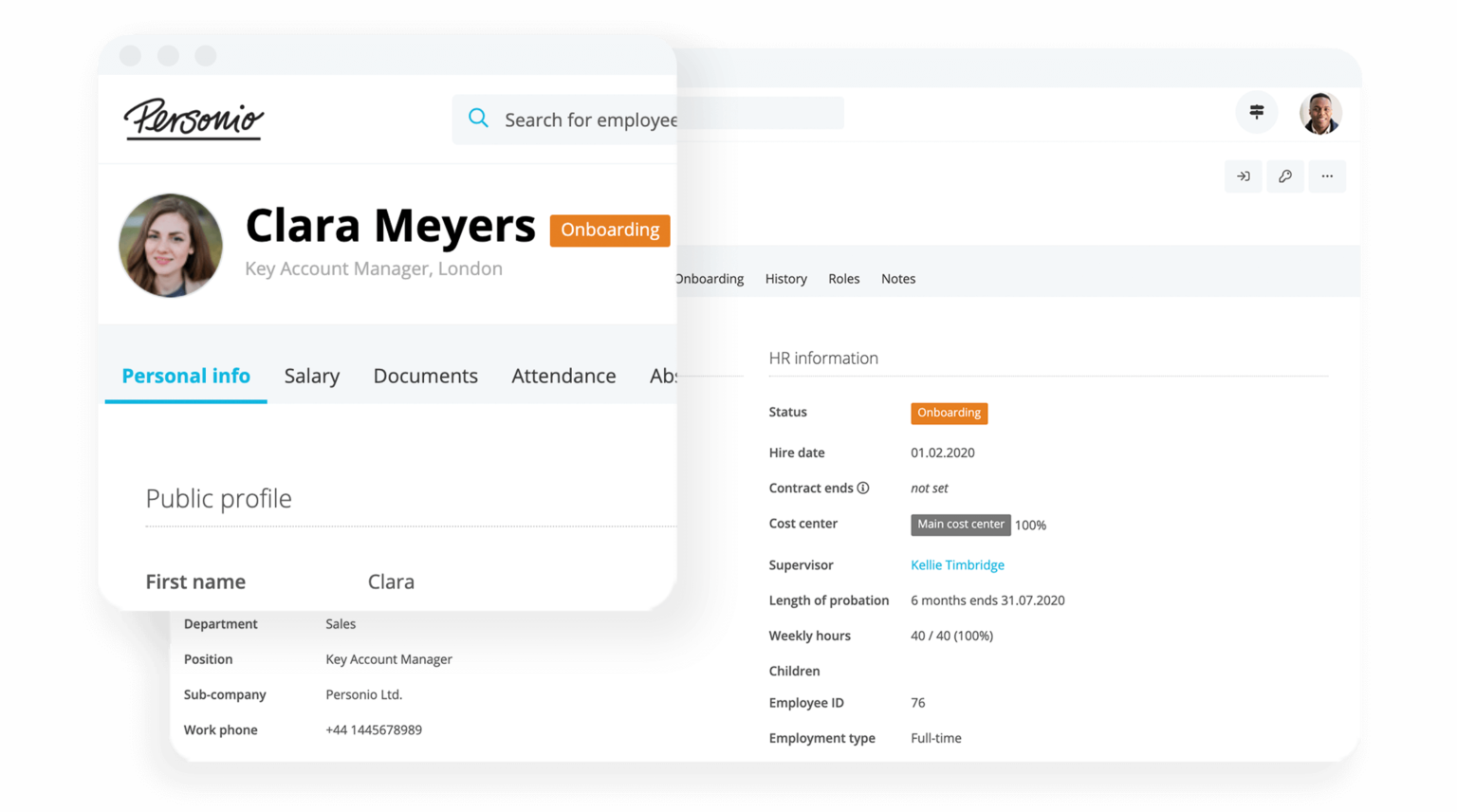
The critical elements of an effective induction program
A great induction helps employees adjust to their new working environment and feel like part of the team. Whether you call it onboarding, orientation or even socialisation, these first few moments, hours or days can set a critical framework for future endeavours.
After all, first impressions can last a lifetime. A good induction can have a positive effect on employee engagement, staff absenteeism, turnover and their perception of the company's employer brand.
A well-developed and streamlined onboarding helps employees settle in and feel comfortable; helps new team members build good relationships from day one; and sets expectations for acceptable behaviour, cultural norms, ethics and ways of working.
With this, you should take a phased induction approach, where key topics are introduced progressively, for example:
Day 1 essentials
Week 1 deep dive
Month 1 review
As Fran Newman, People Director of Deliciously Ella explains: "It’s so much easier because we are able to put in different steps for all of the different people involved and it sends out automated emails and reminders to let them know what they need to do. We’ve been able to make it feel really special and specific to Deliciously Ella.”
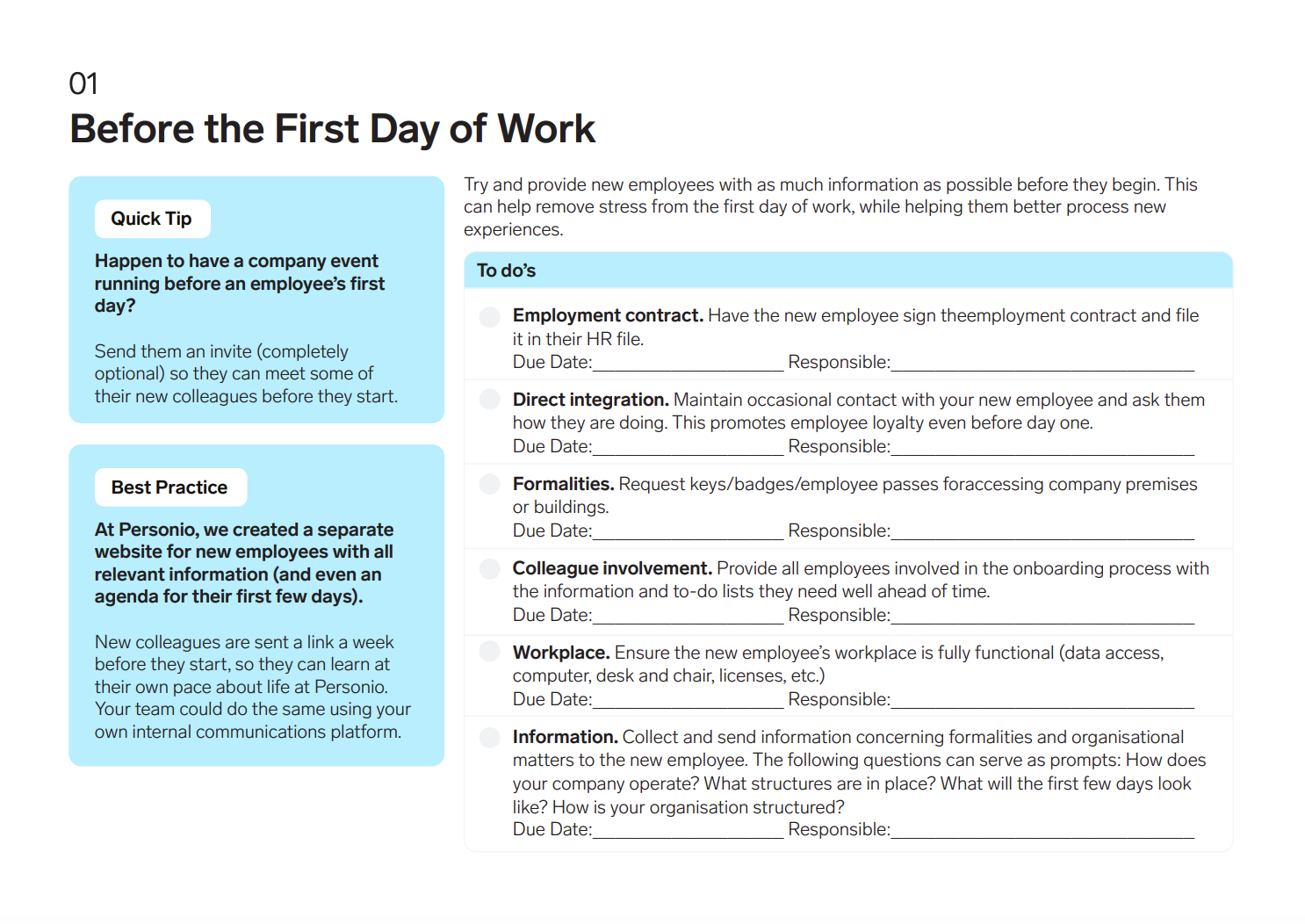
How to build an induction checklist that works
When thinking about creating a great employee induction it helps to answer those traditional questions of who, what, when, where, why and how.
Who?
As part of an employee induction, it’s important to explain who they will be:
Working with directly
Reporting to
Working with indirectly
Interacting with occasionally (for example, C-level executives)
One helpful way of answering the ‘who’ question is by providing an employee with an organisation chart – either in a physical, or digital format.
Discover what it takes to craft a great org chart in this helpful article.
What?
What will an employee actually do on a daily basis? No matter how good their job description is, an employee will still need to know what’s expected from them, what actual tasks need to be done, when and how.
This guide to job descriptions may also prove helpful. Click here to read more.
When?
Hopefully an employee already knows what their working hours, start times and end times are before they begin their first day of work. But it is important to double-check this and to let them know when they can take breaks – including lunch breaks.
Where?
In the past, the ‘where’ of an employee induction was fairly obvious. They work at a specific office location (unless their job requires them to travel) and sit at a specific desk. By the end of an employee induction, they must know where to go to the bathroom, how to find the emergency exits and be able to identify the location of the kitchen and any other office facilities they need to use.
But these days with hot-desking, remote working and even remote onboarding, addressing the question of ‘where’ is somewhat more complicated.
Read our complete guide to hybrid working’s most pressing questions right here.
Why?
Addressing the question of ‘why’ can be tricky in an employee induction, but having a strong, clear and clearly-defined culture can help. In this case, a company’s core values help employees reduce uncertainty when making decisions so they can concentrate on doing their jobs.
By explaining how it’s important for employees to act, sharing things you’re proud of and putting new employees in touch with great cultural ambassadors, it helps them feel part of that culture more quickly.
It also reduces uncertainty and hopefully gives employees a good feeling that makes them want to come back again the following day, week, month and year following.
How?
It’s not always possible to explain how to do the job in full on their first day. So rather than trying to cram all this information in on their induction day, it’s better to give employees a plan of how to get started and then help them along the way, regardless of what questions they have.
An induction checklist is important here, because all of the tasks may not be covered in the first day. This way, you know what has been covered and what is remaining for an employee.
Remember: It’s often nerve-racking for new employees to ask questions, particularly if they feel like the questions are foolish on their part. But helping them through this learning curve will pay dividends later.
Try out our induction checklist today

15,000 customers choose Personio for smooth, reliable onboarding. Download our trusted onboarding checklist to see why by clicking below.
Get it freeAn effective employee induction checklist should cover all essential aspects of a new hire's onboarding process. Here are some key elements to consider:
Administrative requirements:
Employment contract review and signing
Tax forms and documentation
Benefits enrolment (healthcare, retirement)
Emergency contact information
IT setup (computer, email, access rights)
Company policy review (code of conduct, time off, expense reimbursement)
Training and compliance:
Job role and responsibilities
Company products or services
Tools and equipment
Processes and procedures
Performance expectations
Health and safety training
Emergency procedures
Compliance regulations
Company culture and values:
Company history and mission
Core values and beliefs
Organisational structure
Team introductions
Company tour
Introduction to colleagues
Mentorship or buddy program
Social events or team-building activities
The following seven sections cover the essentials you must include when onboarding someone.
1. Get the personal details right
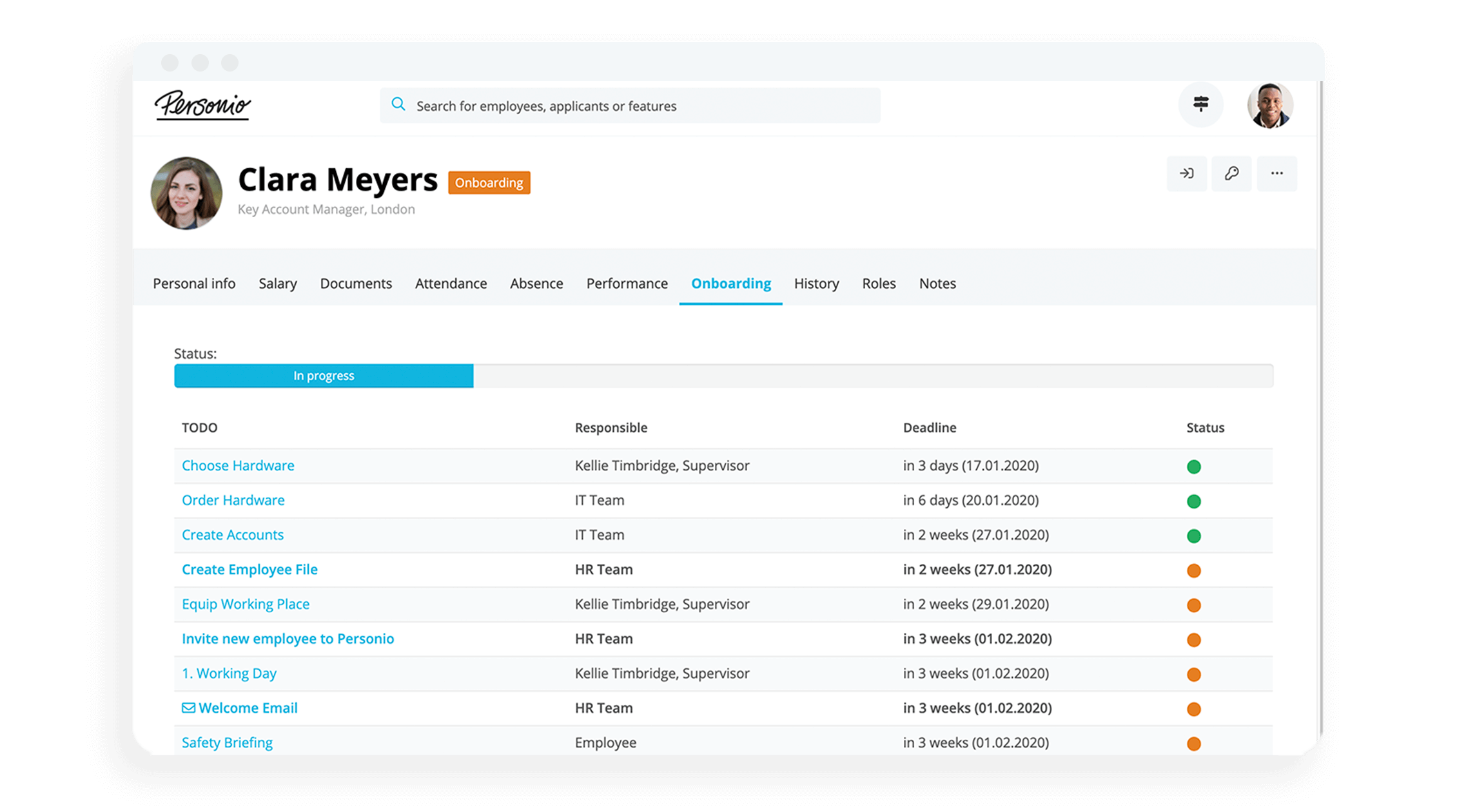
Make sure an employee has signed and returned their contract (if this hasn’t already been done before they start) and check all their official working information including:
Personal contact details
National Insurance (NI) number
P45
Work eligibility including visa or passport information (if applicable)
Background checks (including CRB checks)
Bank account details
2. Make sure they know your policies
Share your employee policies and procedures with them – including information on any portals, noticeboards or other locations like Slack or your intranet.
This should include:
Company culture information
Policies relevant to them
Procedures they must follow
Where to find an employee handbook (if you have one)
3. Cover the essentials
At a minimum, it’s important for your employees to know about their working terms and conditions. Even if this is included in your policy, handbook or employee manual, be sure to point out and make sure they understand the following (and where to find this information):
The facilities you provide
Their working hours
Expected breaks and holidays
Paternity, maternity or shared leave
What happens when they’re sick
How their pension works
Who their manager is
What to do if they have queries, complaints or need help
4. Keep them safe
It is a legal requirement in the UK to ensure relevant health and safety information is covered as soon as an employee starts. This includes:
Any precautions they must take to keep them safe
Any training, or Personal Protective Equipment (PPE) they might need to do their job safely
What they should do if there’s an accident, emergency or in case of a fire
5. Get them set up and ready to work
There’s nothing more frustrating than starting a new job and not being able to work. At the very minimum, an employee must have access to the locations, tools and equipment they need.
Depending on the nature of their work this can include providing:
Laptops and a mobile phone
Access to your work networks (including wifi passwords and relevant logins)
Entry to the building (a key, key code, fob or passwords)
Instructions on how to get into and use any social networks (e.g. Slack/Messenger etc.)
As Nina Johansson, HR Manager at British Rowing explains: “From recruiting, employees go straight into onboarding journeys, which I love. Being able to create so many different journeys for each person you can really make it personalised. The onboarding journey is crucial for people’s success in their job role long-term so it has been a really massive help.”
6. Set the right tone
It is absolutely critical that from induction day, employees feel welcomed into your organisation. When getting them started, you might want to:
Arrange a tour of the company’s facilities
Tell them about the company’s vision, mission and values
Provide printed documents so they don’t forget critical information (or give them a way to write the key information down – branded company pens are a nice touch)
Set up meetings for them to meet key people they’ll be working with
Tell them about training and potentially book it in
Assign an ‘onboarding buddy’
Arrange regular ‘check-in’ meetings with their boss
Introduce them to the wider team by email
Click here for a collection of introduction emails to colleagues (with templates).
7. Help them see what success looks like
This goes beyond discussing their roles and responsibilities. It also helps enormously to explain your company’s standards and expectations, where to go when they have questions and if possible, to give employees a plan for how to get started with the job they need to do and even what it means to be a great employee at your organisation.
This also might include familiarising employees with your performance processes and how your organisation runs reviews. Do you have a process in place? If not, start by checking out our collection of performance review templates today.
8. Be sure to evaluate your induction process
To measure the effectiveness of your employee induction process, focus on key metrics that assess time-to-productivity, employee satisfaction, learning and development, performance and productivity, cost-effectiveness and engagement and retention.
Track time-to-complete training, satisfaction surveys, knowledge retention, performance reviews, training costs, ROI, eNPS and turnover rates. By analysing these metrics, you can identify areas for improvement and optimise your induction process to ensure a positive and successful experience for new hires.
Avoiding common pitfalls in employee induction
During an induction day, there are some things to keep an eye out for. It's important to keep these five red flags in mind before induction day rolls around:
Don’t give them too much information to process all at once. Allow them to take the time they need and to ask questions.
Don’t give them too much to do immediately. But don’t let them sit around with nothing to do, either.
Don’t expect them to get working from day one.They will need time to figure out how your systems and processes work before you can expect them to be effective.
Don’t leave them on their own for too long without support.
Don’t set unrealistic expectations. But do help them know what will help them get up and running soon and what ‘good work’ looks like.
Special considerations for remote employees
Remote employee induction is essential for creating a positive and productive onboarding experience. Here are some best practices to consider:
Effective remote employee induction requires clear communication, technology utilisation, community-building and support. Set clear expectations, leverage technology tools, foster a sense of community, and provide adequate support throughout the onboarding process.
Ensure a smooth transition by planning for equipment delivery, encouraging a comfortable workspace, and addressing technical issues promptly. Gather feedback, analyse metrics, and make necessary adjustments to continuously improve the onboarding experience.
Recharge your employee induction

Our automated onboarding automatically creates checklists, reminders and more. See it in action with your free demo.
Book your free demoTurn your employee induction checklist into automated onboarding process
Having a seamless employee induction is far simpler when the whole process is put together ahead of time. Using Personio’s onboarding, you can ensure that all of your tasks are completed and that an employee has an amazing first day in their new role.
Automation of your onboarding process ensures consistency, saves time and enhances the new hire experience by offering clear expectations and next steps to success.
Measuring the success of your induction program
Key metrics for evaluating an induction program include:
Employee feedback: Gather feedback through surveys or exit interviews to assess employee satisfaction with the induction process and its effectiveness in preparing them for their roles.
Time-to-productivity: Measure the time it takes for new hires to become fully productive in their roles. A shorter time-to-productivity indicates a successful induction program.
Retention rates: Track employee turnover rates to assess the program's impact on employee retention. Higher retention rates suggest a more effective induction process.
Training completion: Monitor completion rates for required training modules to ensure that new hires are receiving the necessary information and skills.
Manager satisfaction: Gather feedback from managers to assess their satisfaction with the induction process and the quality of new hires.
Conclusion: Setting the stage for long-term success
A well-structured induction process is crucial for employee retention, engagement, and overall organisational success.
By providing new hires with the necessary information, training, and support, induction helps employees feel welcomed, valued, and informed, leading to increased job satisfaction, a sense of belonging, and higher productivity. This, in turn, can reduce turnover, improve employee morale, and strengthen company culture.
To encourage continuous improvement of the induction process, it is essential to gather feedback from new hires, managers, and other stakeholders.
This feedback can be used to identify areas for improvement, update training materials, and tailor the induction process to meet changing needs. Additionally, regularly reviewing and updating the induction program to align with company goals and industry trends can help ensure its ongoing effectiveness.
